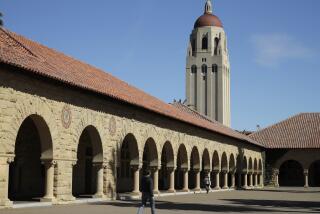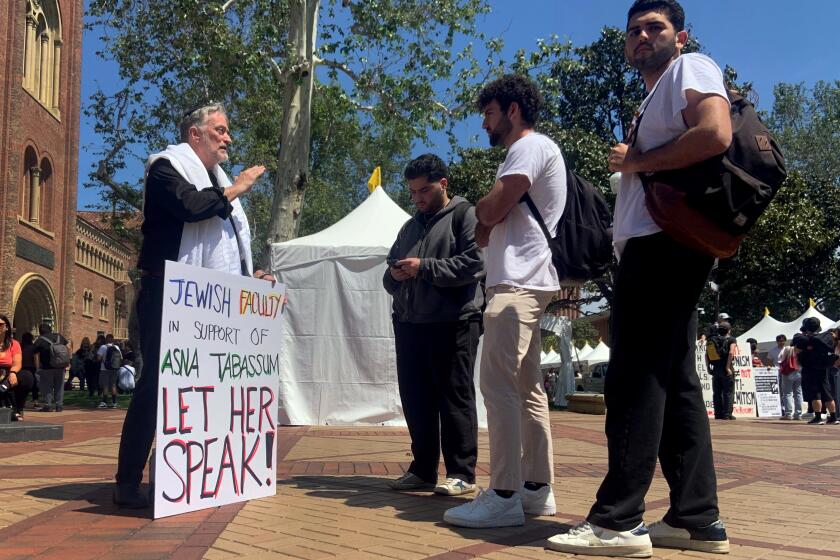Cal State chancellor sets goals for improved graduation rates
California State University Chancellor Timothy P. White on Tuesday announced an aggressive plan to substantially increase graduation rates over the next decade while again calling for more state funding to help achieve those goals.
In a “state of the university” address to the board of trustees, White outlined an ambitious agenda to increase six-year and four-year graduation rates for freshmen, and two- and four-year rates for transfer students.
The nation’s largest university system could produce an additional 100,000 bachelor’s-degree holders by 2025 if it reaches its targets, White said. The plan follows projections by the nonpartisan Public Policy Institute of California that the state will need 1 million more college graduates by 2025 to meet workforce needs.
“The bottom line of the graduation initiative is a path to success for every student — a path that develops core skills in critical reasoning, cultural competency and civic engagement,” White said.
Among the chancellor’s recommendations:
• Increasing the six-year graduation rate for first-time freshmen to 60%;
• boosting the four-year graduation rate for freshmen to 24%;
• increasing the four-year rate for transfer students to 76%;
• and raising the two-year graduation rate for transfers to 35%.
The proposals come at a time when President Obama and California Gov. Jerry Brown, among others, are pressing public institutions to improve student success — and to hold them accountable. The president has proposed a ratings system that would take into account factors including graduation rates, student debt and post-graduation earnings.
Cal State has typically used six-year graduation rates as a benchmark. Brown, though, is pushing the system to focus more on four-year rates.
Increasing those four-year freshman rates — currently at 18% — could prove a heavy challenge for the 23-campus system, which educates more than 450,000 students annually.
Many of them are older, working students who attend part time.
“The four-year graduation rates are abysmal and need to be improved,” said Michele Siqueiros, executive director of the nonprofit Campaign for College Opportunity. “Time to degree matters, because the more time a student spends in college, the more it costs them.”
Siqueiros said success will depend on more state funding and the commitment to move forcefully at the campus level. But she lauded White for setting specific goals, something state education leaders have yet to do, she said.
Notably absent from the chancellor’s address was any plan to raise tuition — at least not in the near term. White, in fact, signaled the opposite, aligning with Brown on the issue. Brown has criticized a plan by the University of California to raise tuition by as much as 5% in each of the next five years.
“I must agree with the governor, that students should not be the default financiers of higher education,” White said. “But the historical financiers of higher education — the people of California — are ill-served if their public universities crumble due to lack of sufficient investment.”
Brown, though, has balked at providing additional state funding to either UC or Cal State beyond the $119.5 million proposed in his 2015-16 budget. Cal State requested an additional $216.6 million in state funding, part of which would be used to enroll an additional 12,000 students. Brown’s plan would allow for an additional 3,500.
Robert Shireman, executive director of the nonprofit advocacy group California Competes, noted Brown’s argument that both Cal State and UC can do more with less but suggested the governor might be impressed with White’s proposals.
“I think the governor realizes that Cal State is a modest-cost institution in terms of what it’s spending on students, and maybe with White’s commitment here, he will loosen up on more state spending,” Shireman said.
The system is on target to meet a previous goal, boosting six-year graduation rates by 8 percentage points — from 46% to 54% — by 2015, officials said. Meanwhile, funding from the state and student tuition is $8,000 less per degree earned than a decade ago, White said.
“The CSU is lean and efficient,” said White, adding that more state funding is essential.
The chancellor also is seeking to close achievement gaps among low-income and minority students.
The system plans to expand many of the efforts it is already undertaking, including reducing the number of units required to earn a bachelor’s degree, redesigning courses to improve retention, easing access for transfer students, expanding online courses and academic advising and hiring more tenure-track faculty.
Many of those strategies are working at Cal State Los Angeles, which has seen graduation rates rise steadily, said President William Covino. The campus, with more than 24,000 students, is in the midst of converting from a quarter to a semester system and has redesigned about 4,000 courses.
But the graduation numbers still need improvement, he said, especially for students who are the first in their families to attend college.
“It still needs to get better,” Covino said. “The numbers reflect the challenges that first-generation college students have.”
His campus, as others, is increasingly looking to outside funding to support academic programs and student services, he said.
Meanwhile, although overall tuition hikes aren’t on the agenda, the system has been criticized for enacting so-called student success fees at a dozen of the 23 campuses. The fees — which range from $162 to $830 at full implementation — are designed to hire faculty, increase course offerings and improve other services that were reduced during years of state funding cuts.
Many students, however, maintain that they hadn’t had sufficient input before the fees were adopted and that the charges backtrack on a promise of flat tuition in exchange for increased state funding.
Trustees are scheduled to vote Wednesday on several policy changes, including requiring a binding student vote before enacting new fees. The recommendations, however, do not call for a rollback of current fees.
Twitter: @carlariveralat
More to Read
Start your day right
Sign up for Essential California for news, features and recommendations from the L.A. Times and beyond in your inbox six days a week.
You may occasionally receive promotional content from the Los Angeles Times.







